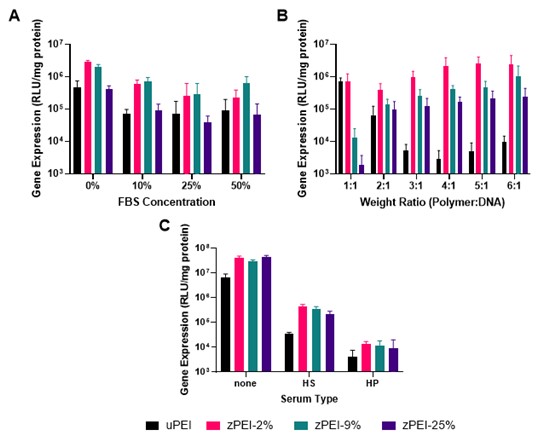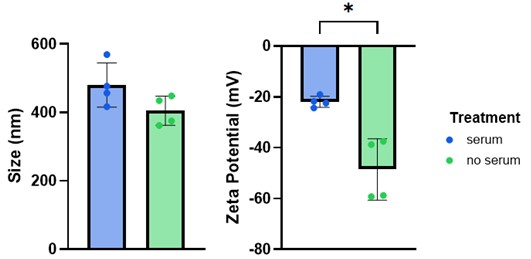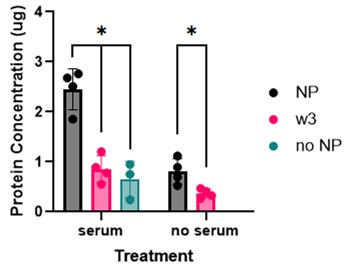TRACK 1: Inspiring Innovation in Formulation, Bioprocessing, and Drug Delivery
Category: Poster Abstract
(M0930-02-06) Investigations into the Effects of Protein Corona Formation on Novel Polymeric Nanoparticle Systems
Monday, May 5, 2025
9:30 AM - 10:30 AM ET

Leah Schrass
Research Assistant
University of Kentucky
Lexington, Kentucky, United States
Leah Schrass
Research Assistant
University of Kentucky
Lexington, Kentucky, United States- DK
Daniel Kolpek
University of Kentucky, United States
- DP
Daniel Pack
University of Kentucky, United States
- JP
Jonghyuck Park
University of Kentucky, United States
Presenting Author(s)
Main Author(s)
Co-Author(s)
Purpose: Upon exposure to biological solutions, nanoparticles interact with proteins present in the solution. These proteins adsorb to the surface of the nanoparticle in unique ways forming a protein corona.1 The protein corona is then responsible for directing the biological response to the nanoparticle.2,3 Therefore, understanding more about how to characterize the protein corona and its effects is an essential aspect for continued development of nanoparticles for drug and gene delivery applications. The goal of this research is to investigate two polymeric nanoparticle systems that have shown beneficial effects compared to counterparts for in vitro and in vivo applications. Specifically, a succinylated polyethylenimine (zPEI) that shows significantly increased transfection efficiency compared to unmodified polyethylenimine (uPEI).4,5 Also analyzed is a poly-lactic-co-glycolic acid nanoparticle modified with poly (ethylene maleate) (PLGA-PEMA) that has potential uses in various disease models.6,7 Evaluation of these systems will allow for a greater understanding of the effects of protein corona formation in both polymeric delivery and treatment applications. The hypothesis is that the formation of the protein corona increases cellular adhesion and internalization of the zPEI nanoparticles improving transfection efficiency. Additionally, it is hypothesized the protein corona formation attracts immune cells directing their response to PLGA-PEMA nanoparticles in vivo.
Methods: For in vitro analyses of the effects of protein corona formation, the zPEI nanoparticles were compared to a uPEI control. Transfection efficiency experiments were performed on HeLa cells with a luciferase plasmid to allow for assay analysis. These experiments measured several factors of protein exposure including concentration, weight ratio and serum type. Standardization of these experiments with a BCA assay reduced variability based on cell count and serum concentration. Further protein corona characterization experiments evaluated the effects on a PLGA-PEMA nanoparticle. After incubating PLGA-PEMA nanoparticles in serum, a centrifugation purification procedure separated the protein corona-nanoparticles from free proteins in solution. The nanoparticles were then characterized using dynamic light scattering and zeta potential analyses. Protein concentration in the corona of the nanoparticles was measured with a BCA assay and compared to the washes from the centrifugation and centrifuged serum. Additionally, after resuspension in Laemmli buffer, SDS-PAGE analysis provided a qualification of the protein corona adsorbed to the PLGA-PEMA nanoparticles that was compared to unexposed nanoparticles and serum controls to verify protein banding patterns.
Results: First, changes in transfection efficiency after zPEI exposure to a range of serum concentrations were measured. While there were fluctuations in transfection efficiency, zPEI maintained its ability to produce higher transfection compared to uPEI despite the changes in serum exposure. Different weight ratios of polymer to DNA were also examined with exposure to 50% FBS and demonstrated similar trends to those previously seen with 10% FBS.5 Finally, an analysis of zPEI nanoparticles in human serum and plasma also showed similar increases in transfection efficiency with zPEI compared to uPEI. Along with the in vitro characterizations of protein corona effects on transfection efficiency, protein corona development was evaluated around PLGA-PEMA nanoparticles. With serum exposure, the PLGA-PEMA nanoparticles demonstrate an increase in size and decrease in charge with protein corona formation. Furthermore, the centrifugation purification procedure used for analysis was verified through BCA assay where significant differences in protein concentrations were observed between the protein corona on the nanoparticles, the wash solution and centrifuged FBS. Finally, in the SDS-PAGE analysis, qualitative differences were also observed between the nanoparticle protein corona and FBS. Unique banding patterns were observed signifying higher concentrations of specific proteins in the corona of the PLGA-PEMA nanoparticles compared to the concentrations in FBS.
Conclusion: Based on the transfection experiments, the protein corona is observed to modulate the differences in efficiency between zPEI and uPEI nanoparticles. This indicates that the effects of the protein corona on gene delivery can be evaluated in vitro. Furthermore, the protein corona is responsible for the specific changes between uPEI and zPEI nanoparticles. Future work will investigate this further by determining the presence of specific proteins in the corona such as apolipoproteins, IgG and vitronectin which can have beneficial effects for cellular association to HeLa cells.8 Based on the BCA assay analysis of the PLGA-PEMA nanoparticles, the centrifugation method is a proper way to purify these nanoparticles with an intact protein corona. Additionally, the DLS and zeta potential analysis of the PLGA-PEMA nanoparticles indicates that they follow previously determined trends in the effects of the protein corona on size and charge. Finally, the characterization of the protein corona with SDS-PAGE confirms the uniqueness of the corona surrounding the PLGA-PEMA nanoparticles. This qualitatively shows differences between the protein corona and proteins in serum, as well as further confirming the purification of the nanoparticles with an intact corona. The next steps in research on PLGA-PEMA nanoparticles will investigate specifics of the protein corona to determine potential increases in opsonins such as immunoglobulins and some apolipoproteins which could lead to benefits for targeting immune cell treatment.9
References: 1 Kopac, T. Protein corona, understanding the nanoparticle-protein interactions and future perspectives: A critical review. INternational Journal of Biological Macromolecules 169, 290-301 (2021).
2 Gräfea, C. et al. Intentional formation of a protein corona on nanoparticles: Serum concentration affects protein corona mass, surface charge and nanoparticle-cell interaction. The International Journal of Biochemistry & Cell Biology 75, 196-202 (2015).
3 Ritz, S. et al. Protein Corona of Nanoparticles: Distinct Proteins Regulate the Cellular Uptake. Biomacromolecules 16, 1311-1321 (2015).
4 Uddin, N., Warriner, L. W., Pack, D. W. & DeRouchey, J. E. Enhanced Gene Delivery and CRISPR/Cas9 Homology-Directed Repair in Serum by Minimally Succinylated Polyethylenimine. Molecular Pharmaceutics (2021).
5 Warriner, L. W., Duke, J. R., Pack, D. W. & DeRouchey, J. E. Succinylated Polyethylenimine Derivatives Greatly Enhance Polyplex Serum Stability and Gene Delivery In Vitro. Biomacromolecules 19, 4348-4357 (2018).
6 Kolpek, D., Kim, J., Mohammed, H., Gensel, J. & Park, J. Physicochemical Property Effects on Immune Modulating Polymeric Nanoparticles: Potential Applications in Spinal Cord Injury. International Journal of Nanomedicine Volume 19, 13357-13374 (2024).
7 Park, J. Immunomodulatory Strategies for Spinal Cord Injury. Biomedical Journal of Scientific & Technical Research 45 (2022).
8 Palchetti, S. et al. Nanoparticles-cell association predicted by protein corona fingerprints. Nanoscale 8, 12755-12763 (2016).
9 Spreen, H., Behrens, M., Mulac, D., Humpf, H.-U. & Langer, K. Identification of main influencing factors on the protein corona composition of PLGA and PLA nanoparticles. European Journal of Pharmaceutics and Biopharmaceutics 163, 212-222 (2021).
 Figure 1: Changes in Transfection Efficiency with Serum Exposure Transfection efficiency was measured in HeLa cells using a range of zPEI nanoparticles after serum exposure compared to uPEI nanoparticles. A) Analysis of the effects of increasing fetal bovine serum (FBS) concentration on transfection efficiency with pre-incubation of nanoparticles before introduction to cell culture. B) Evaluation of the effects of weight ratio on transfection efficiency for zPEI and uPEI nanoparticles pre-incubated with 50% FBS. C) Determination of the transfection efficiency for zPEI nanoparticles pre-incubated in 50% human serum (HS) and human plasma (HP). All error bars represent standard deviation.
Figure 1: Changes in Transfection Efficiency with Serum Exposure Transfection efficiency was measured in HeLa cells using a range of zPEI nanoparticles after serum exposure compared to uPEI nanoparticles. A) Analysis of the effects of increasing fetal bovine serum (FBS) concentration on transfection efficiency with pre-incubation of nanoparticles before introduction to cell culture. B) Evaluation of the effects of weight ratio on transfection efficiency for zPEI and uPEI nanoparticles pre-incubated with 50% FBS. C) Determination of the transfection efficiency for zPEI nanoparticles pre-incubated in 50% human serum (HS) and human plasma (HP). All error bars represent standard deviation. Figure 2: Size and Charge Differences with PLGA-PEMA Nanoparticle Serum Exposure Size and zeta potential were measured after PLGA-PEMA exposure to 50% FBS. The size of the nanoparticles increased by ~80 nm and the charge decreased ~ 30 mV after protein corona formation. Error bars represent standard deviation and * is a p-value < 0.05.
Figure 2: Size and Charge Differences with PLGA-PEMA Nanoparticle Serum Exposure Size and zeta potential were measured after PLGA-PEMA exposure to 50% FBS. The size of the nanoparticles increased by ~80 nm and the charge decreased ~ 30 mV after protein corona formation. Error bars represent standard deviation and * is a p-value < 0.05. Figure 3: PLGA-PEMA Protein Corona Concentration after Centrifugation Purification The concentration of protein in the PLGA-PEMA nanoparticles was evaluated after exposure to 50% FBS and a three-wash centrifugation procedure (16,000 g for 10 min). Final concentration of protein in the corona (NP) was greater than the concentration in the third wash solution (w3) and a centrifuged solution of FBS alone (no NP). Error bars represent standard deviation and * is a p-value < 0.05.
Figure 3: PLGA-PEMA Protein Corona Concentration after Centrifugation Purification The concentration of protein in the PLGA-PEMA nanoparticles was evaluated after exposure to 50% FBS and a three-wash centrifugation procedure (16,000 g for 10 min). Final concentration of protein in the corona (NP) was greater than the concentration in the third wash solution (w3) and a centrifuged solution of FBS alone (no NP). Error bars represent standard deviation and * is a p-value < 0.05.